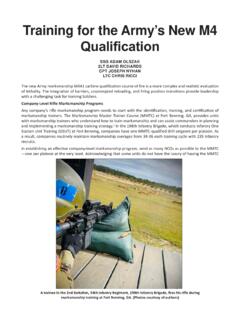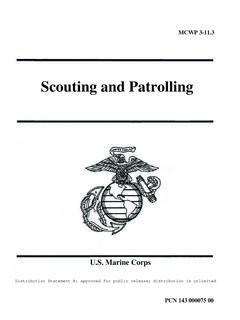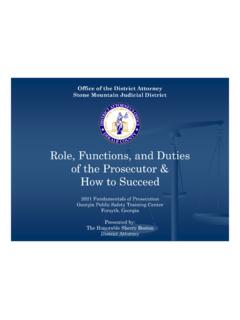Transcription of A Level Media Studies – Set Product Fact Sheet The Mirror
1 The Mirror (13 March 2019)A Level Media Studies Set Product Fact Sheet1 The Mirror (13 March 2019)AS Level Component 1: Investigating the MediaA Level Component 1: Media Products, Industries and Audiences. Focus areas: Media language Representation Media industries Audiences Media contextsPRODUCT CONTEXT The Daily Mirror is a British daily national tabloid newspaper. Established in 1903, it is aimed at predominantly working class readership. It follows a traditionally left wing political stance. One of the Mirror s main competitors is The Sun newspaper which targets a similar socio-economic demographic, but usually adopts a more traditionally right wing stance. This edition was published on March 13th, 2019, after Theresa May had encountered another Commons defeat over her Brexit proposals. As a mostly left-wing newspaper, the Mirror has been critical of the way the conservative government has been handling the Brexit 1: STARTING POINTS Media language and representationPolitical contextOn 23rd June 2016, citizens of the UK voted to leave the European Union (EU).
2 This was nicknamed Brexit . The vote was very close with voting to leave and voting remain. The controversies from the campaign continued even after the vote. Remainers accused leave voters of xenophobia and racism; leavers accused remainers of being unpatriotic and period since the referendum has been one of political turmoil. Following the resignation of David Cameron shortly after the vote, Theresa May has faced regular leadership challenges from within her own party, and a snap general election in 2017 in which her party suffered heavy losses. Meanwhile, she had been regularly visiting Brussels and other EU countries in an effort to create a Brexit deal that would satisfy both the EU and the UK the date this edition of the Mirror was published, MPs had voted against the deal she had negotiated with the EU. This was very serious as the UK was scheduled to be leaving the EU just ten days from the EU with no deal could have catastrophic consequences on trade, immigration, healthcare etc.
3 , affecting all UK contextEastenders is one of the UK s most popular soap operas, with a reputation for featuring hard-hitting storylines that often feature issues such as rape, domestic violence and homophobia. Since 1985, it has been regularly watched by audiences of up to 20 million people. This has turned the actors into celebrities and - like Dyer s Star Theory suggests - tabloid newspapers often run stories about the actor s lives mirroring their Eastenders , one of the Mirror s (and other tabloids ) main elements is sports reporting - often over half the paper is dedicated to sport. The back pages often feature the betting odds for horse races and will have special pull out features when there is a major racing event. Racing meets like Ascot and Cheltenham have upper class associations, but have increasingly become popular days out for the less wealthy audiences.
4 Front page: The page is split between the political story, a puff box promoting the pull-out supplement, and an advert for a betting service (that obviously links to the Cheltenham pull-out). The headline Brexit Delay Mayhem and the use of the emotive words surrender , defeat and chaos suggest the negotiations for Britain leaving the EU are Level Media Studies Set Product Fact Sheet2 The image of May looking very serious anchors the headline - that fact the image is tiny (smaller than the photo of attacked actor in the top right) shows how little respect or faith the Mirror has in May s abilities. The strapline fighting for you provides solidarity for people confused or worried about the political turmoil of Brexit. The Cheltenham Festival pull-out actually dominates the page - with bright green font and background, combined with an exciting action shot of a horse and rider, it grabs the attention more than the political story.
5 The puff box All the tips! All the form! offers practical advice and the offer of a free bet will also entice the reader. The use of these terms positions the reader as someone already knowledgeable about racing. The advert at the base of the page also uses brightly coloured graphics, the greens linking it to the racing feature above. The article about the assault on the actor is a close-up of her upset face, to create empathy and the reader feel closer to this character . The headline uses emotive slang like glassed and thug to condemn the attack. It also doesn t use the real actor s name (Katie Jarvis) instead addressing her as her character s name. The abbreviation of Eastenders along with the slang suggests this story is less important and more gossipy .Article: The central image is a medium shot of Theresa May: her hands are raised which could connote defeat. It could also indicate conciliation or resistance.
6 The text of the article shows it is a mixture of all of these! May is portrayed as someone who is losing, but who is also bravely fighting on against the odds. The language of the whole article is allegorical: portraying the debate in Parliament as if it is a horse race. A Faller At The 2nd is racing track slang for a poorly performing horse, and there is even a book-keeper character at the bottom of the page, offering odds for the different Brexit outcomes. Throughout the main article, May is described using light-hearted derogatory language ( tottering Theresa ). Though her dwindling authority is ridiculed, at some points her efforts sound almost heroic ( dashing to Brussels ). On either side of the double page there are two rival columns offering opposing viewpoints on the proceedings. The style of these is similar to that of sports journalism, and there are numerous light-hearted pop culture references ( comparing one man to Gandalf from Lord Of The Rings and including his famous line You shall not pass ).
7 Theoretical perspectives: Structuralism Levi StraussThere is a binary opposition between the MPs and the Nation which feeds into the us vs them ideology of populism . There is also an opposition between the two political pundits on the double page piece. The language in the headlines (plus the odds from Honest Jason ) also explains some quite complex political debates in using the allegory of a horse race - this dramatises the details (and also links to the paper s main advertisers!)Starting points: RepresentationConsider how representations are constructed through a process of selection and combinationFront page: By reducing Theresa May to the smallest image on the page, the Mirror is sending a clear message about the way she is seen by her fellow MPs and by the newspaper s target audience. The headline focuses on her defeat and implies the whole situation is her fault - there is very little description of the MPs who have challenged her.
8 This personalises a complex story by making it about the experiences of one individual rather than a complicated political progress involving hundreds of people. This is a technique used by news Media to help audiences build emotional engagement about dry political or economic stories. The small amount of space given to the whole story - along with the ..Loses Key Vote Again headline - suggests that, these political conflicts have become almost commonplace, and this is all part of the ongoing Brexit chaos . Both this and the Eastenders story could suggest women are weak and vulnerable: May surrenders , Hayley has been physically assaulted. Yet the images - May in mid-argument, Hayley looking defiant - give the impression of inner strength despite the attacks they have experienced. The Mirror has an even gender split in their audience, which may explain this more complex portrayal of Level Media Studies Set Product Fact Sheet3 Article: The portrayal of May as embattled continues with a blow by blow account of the debate.
9 The detail of her losing her voice again represents her as both weak, but also relentless in her aims. The image of her dominates the page, whilst the male politicians are in far smaller photo-boxes. There is a sense that even though she is failing, she is going down fighting . Though this seems at odds with the Mirror s political bias, it does fit with the large female market who may admire May s tenacity even if they don t like her perspectives:Feminist theory Van ZoonenVan Zoonen suggested that women are often portrayed as sexualised, weak or vulnerable in the Media . Though the two women featured on the Mirror s cover are from stories that seem to portray them as vulnerable, the images used connote strength and defiance in the face of adversity; also neither are sexualised (almost a genre convention in many other UK tabloids!)PART 2: UNDERSTANDING Media INDUSTRIES AND AUDIENCES STARTING POINTS Media IndustryIndustry contextThe Daily Mirror was first published in 1903 as a newspaper for women to act as a Mirror on feminine life.
10 However the newspaper was quickly redesigned to appeal to a broader by the Reach plc, the Daily Mirror was once the most popular tabloid in the UK. However, it has had the largest year on year fall in sales of any national print newspaper in recent years with a current average daily sales of just 509, 000 copies (Jan 2019).Online Media has largely been responsible for the downturn in print sales and the Daily Mirror has responded to this by launching Mirror Online and having a presence on social Media sites. The website offers interactive opportunities for its readers with competitions, polls and a Got a story? feature which invites readers to submit their own stories. Though it doesn t invite users comments on political issues, it does have accessible stories breaking down the key events into bitesize chunks ( 5 Facts ). This reinforces the Mirror s brand being the Intelligent Tabloid.







